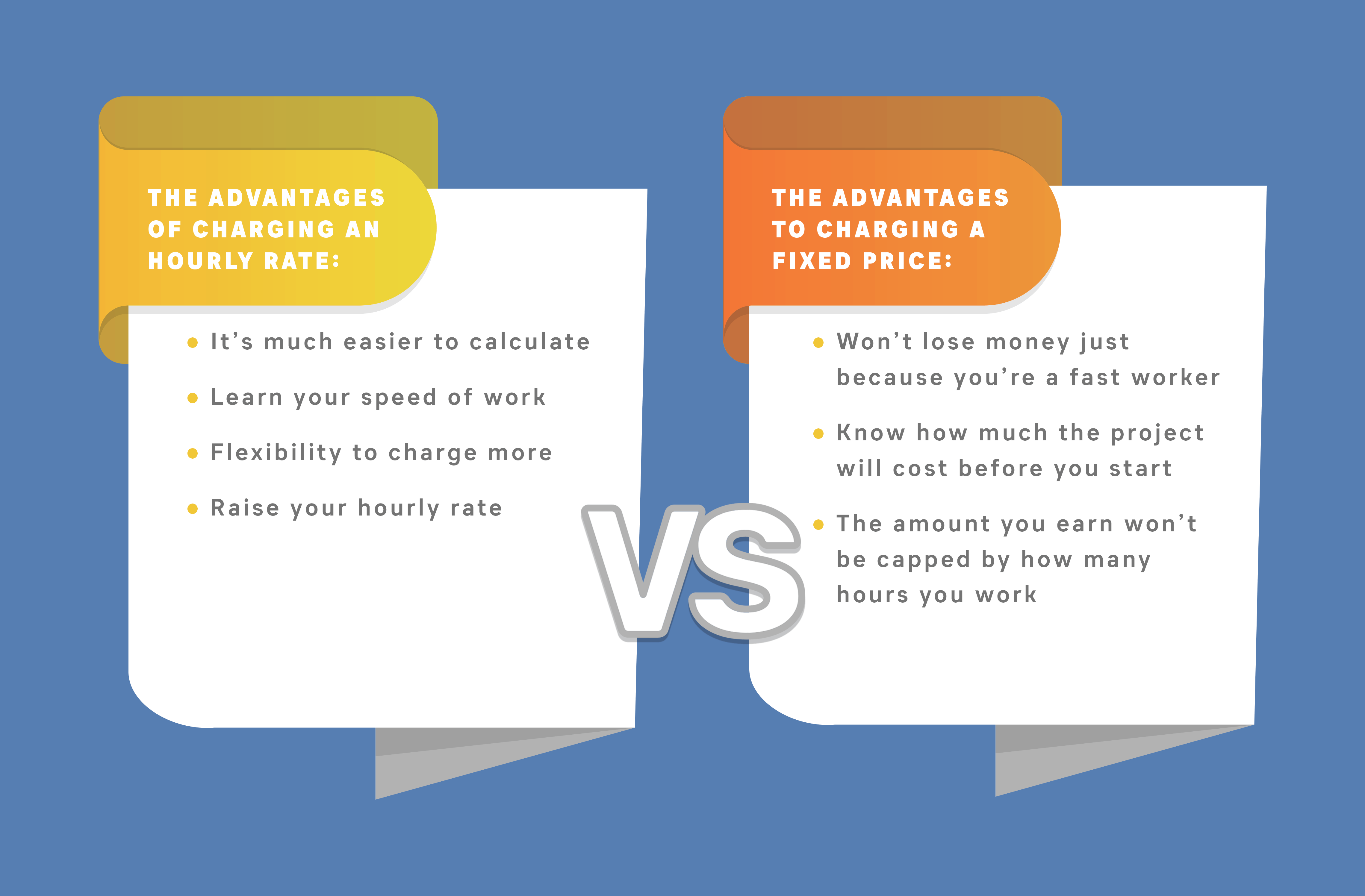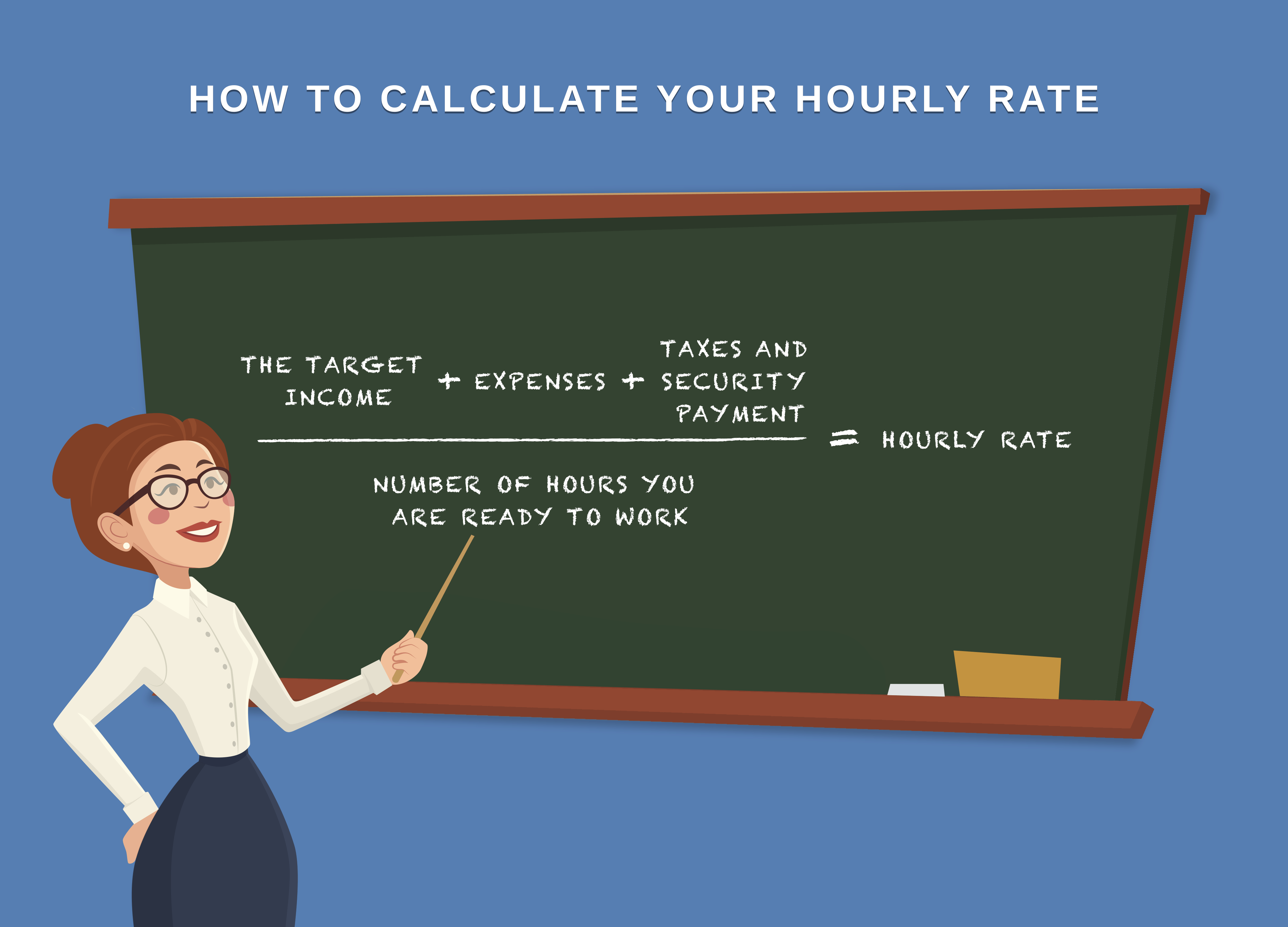How to Set Your Prices as a Freelancer
Before you decide how much to charge, you need to do some research. Reach out to other freelancers to ask what they charge for similar work. You can also use websites like the Freelancer’s Union, HelloBonsai Freelancer Rates’ Explorer, or GlassDoor to investigate average rates for your field. Remember that certain factors play a big part in how much you can charge:- Geographic location: The same work carried out in the Philippines is priced lower than if it were done in the U.S.
- Years of experience: Naturally, the more experienced you are, the more your time is worth
- Industry subset: 3D design projects pay a lot more than 2D web design, for example
- Qualifications: In some fields, a college degree or other certification can allow you to charge more
- The complexity of the project: A complex project means more hours of work and more advanced skills, which means more money
When you calculate your rate, you need to take payment processing fees into account. Some platforms, like Upwork and Fiverr, charge the client for the cost of payment processing. But if you’re getting paid through PayPal, for example, you’ll have to pay 2.9% + $0.30 for every payment. Other payment platforms like Wave and Due also charge payment processing fees. It might not be much each time, but it can really add up. So add the cost of payment processing onto your price quotes.
As you gain experience, you can gradually increase your rates. It’s always important to review your rates after the first six months. If clients are turning you down for projects you know are suitable for you, it could mean that you need to lower your prices. Alternatively, you might get a pleasant surprise when clients offer to pay you more than you requested, because you’re undercharging.
Keep in Mind: Rates are not permanent. If a client offers a steady stream of continuous work, you might want to give them a discount. If you have a client that asks for a lot of revisions, you might want to charge them more (or charge by the hour instead of according to a fixed rate). Also, remember to check your rates every year against the industry standard. The industry can change, and that means so can your rates.
What’s Better, Hourly Rates or Fixed Rates?
Some freelancers have an hourly rate, while others prefer to charge a fixed rate for each project. We can’t tell you which is the best option for you – there is no right or wrong answer. In fact, you’ll probably find there are some situations when it’s best to charge per hour, and others when a fixed project rate will be better. Here’s a clear rundown of the pros and cons of each method of pricing.Pricing per Hour
Working according to an hourly rate means you charge the client according to the number of hours you work for them.- It’s much easier to calculate than trying to work out the value of a project
- It gives you the flexibility to charge more if the work takes longer than expected
- As you get more experience, you can just raise your hourly rate
- Being a fast worker means that you earn less money
- When you get more experience, you’ll risk hitting a price ceiling where you need to charge such a high hourly rate that clients won’t be willing to pay it
- An hourly rate limits you to only earning money according to how long it takes you to work
Fixed Price
Fixed rate pricing means that you quote a single price for the entire project.- You won’t lose money just because you’re a fast worker
- The client knows exactly how much the project will cost before you start, giving both of you a sense of confidence
- The amount of money you earn won’t be capped by how many hours you can work in a day
- Psychologically, a client is more likely to agree to a project rate of $300 than an hourly rate of $150 for two hours of work, even though the total amount is the same
- You might get a bonus from the client if you do a great job
- Deciding on your price can be complicated – you’ll need to be able to estimate how long the project will take before you set your price
- You’ll have to include deadlines, how many edits you’ll allow (if relevant), and all other elements so you won’t be surprised by extra requests
- If the project turns out to take longer than expected or the client throws in additional requests, you’ll either have to renegotiate for a higher rate, or accept the fact that this time you’ll be paid less

How to Choose between Hourly and Fixed Rates
If you’re not sure which pricing model is best for you, ask yourself these questions:- Is this likely to be a very short job? If so, fixed rate is best. Some tasks can take under half an hour, but carry a lot more value than your hourly rate divided by two
- Is the client unclear about what they want from you? In this case, charging by the hour saves you from effectively working for free because the client keeps changing their mind
- Are you unsure how long the project will take? If you don’t know how to work out a fixed price, an hourly rate is far simpler and easier to calculate
How to Calculate Your Hourly Rate
If you choose to charge by the hour, you’ll need to calculate your hourly rate. There are two main approaches: 1. Calculate how much you’ll need to earn, and work backward: Many experienced freelancers advise beginners to take this approach because it is the simplest and doesn’t require a great understanding of the norms in your field. To calculate your hourly rate, you’ll first need to work out how much income you want to earn each month.- Total all of your expenses, including office rent, insurance, vital business tools, accounting costs, etc., and add that to your desired income
- Add the amount that will be deducted for taxes and social security payments
- Calculate how many hours you’re planning to work each month
- Finally, divide your total desired monthly income by the number of hours you’re willing to work, and that will be your hourly fee


How to Calculate a Fixed Price for a Project
Calculating a fixed price might seem like a complex task, but we’re here to assist you. In essence, you should base your project’s fixed price on the value of the time and skills you will invest into it. In order to calculate your fixed price, consider the following:- How long will it take? This is the baseline for every project rate. By now, you should know roughly how long it takes you to develop three logo options, write 1,000 words, or edit three hours of video, for example. Don’t forget to consider the time needed for phone calls, research, or meetings. Multiply the estimated time by your regular hourly rate to get a starting point for your fixed price.
- How prestigious is the project? You can charge more for a project for a New York hotel chain than for a project for a local coffee shop. You need to price according to your client’s market, not your local market.
- Will it tie up all of your time? If you need to put all other projects on hold for the next month to fulfill this client’s needs, you should increase your price. Exclusive access to your skills comes at a cost.
- What’s the timeline? If you’ve been asked for a rush job to be ready by the next morning, raise your price. Similarly, if a client begs for something to be completed over the weekend or during a national holiday, add a premium for holiday rates.
- Is this client easy to work for? It’s only fair that clients who pay on time and communicate clearly and politely get better rates than the ones who are obnoxious, demanding, and impossible to please. If you find it hard to work for a certain client, raise your prices so they are high enough to make the project worth your time and effort (or high enough to scare the client off, so you can focus on clients you enjoy working with).
- What is the client’s budget? This shouldn’t be the foundation of your pricing, but asking the client for their budget gives you a sense of how much they value the project. It both protects you from accidentally under-charging and stops you from setting your prices out of your client’s reach.
Mastering Value-based Pricing
There’s one slightly different approach to take to calculating a fixed price for a project, and that’s called value-based pricing. Value-based pricing means charging based on the value of your work, instead of the value of your time or skills. To make this clearer, imagine you’re a graphic designer who was asked to design a new logo. You could either think of this as three hours of design work, plus two hours of meetings and exclusive access to your 10 years of design experience, or you could consider that you are selling a product, namely a new logo, and think about how much that new logo is worth to the client.How to Deal with Challenges to Your Pricing
Everyone loves it when a client offers to up your rate because they love your work. Yes, it’s quite rare, but it’s been known to happen. But what about when the client offers to pay less than what you think is reasonable for the project? This is a scenario almost every freelancer faces at some point in their career. The first step is to consider the client’s point of view. Perhaps you overcharged them? Reread the project description and check with other freelancers to see if the listed price is appropriate. If you feel confident that your pricing was correct, don’t be shy to get back to the client to restate your case. Break down the reasoning behind your fees, and point out how much the client could expect to pay for similar tasks. It’s possible that the client will come around and agree to your price. But what if the client is adamant about paying a lower rate than what you believe you deserve? Well, that’s when you need to decide whether or not the project is worth it for you. Here are some reasons why you might choose to accept a lower price offer from your client:- You’re just starting out as a freelancer, or just beginning to work in a new subset of your field. As you gain experience, you’ll be able to raise your prices with all of your clients, including existing ones.
- The client has a lot of potential work for you. It could be worthwhile to accept a lower rate for the first project, with the expectation of being able to negotiate a higher rate for future projects, once you’ve impressed the client with your skills.
- It’s a very prestigious client. Having this client’s name in your portfolio means that you can raise your rates for other clients, which balances out the lower rate that you may be earning now.
- You’re signing this client up as a retainer client, meaning that the client agrees to pay you a fixed amount per month, regardless of how much work is sent in a given month. Retainer clients usually get a lower hourly or monthly rate to compensate for the likelihood that you won’t meet the maximum work hours every month.
- The client can’t afford to pay any more, but you believe in his or her business or vision. Sometimes, freelancers work at a reduced rate for a non-profit organization, or for a startup that they want to see succeed.
Action Items
- Calculate how much money you need to earn each year to cover expenses and net a profit.
- Research rates charged by other freelancers in your field, including Glassdoor, Upwork, and Fiverr.
- Decide whether you would like to go the hourly or fixed price route and determine your fees accordingly.
Main Page: The Ultimate Guide to Being a Freelancer
Chapter 1: Finding a Freelance Job
Chapter 2: How to Create a Winning Freelance Profile
YOU ARE HERE – Chapter 3: How to Price Your Freelance Work
Chapter 4: How to Book a Freelance Job
Chapter 5: How to Discuss a Freelance Project with Your Client Before You Start
Chapter 6: How to Navigate the Freelance – Client Relationship
Chapter 7: How to Manage Your Time as a Freelancer for Maximum Productivity
Chapter 8: How to Get Paid as a Freelancer
Chapter 9: Managing Your Finances as a Freelancer – A Comprehensive Guide
Chapter 10: How to Advance Your Freelance Career
Chapter 11: How to Be a Freelancer & Keep Your Day Job
Feel free to share this article and/or copy this post or parts of it to your website, blog, or social networks. All we ask is that you attribute it to WebsitePlanet.com










